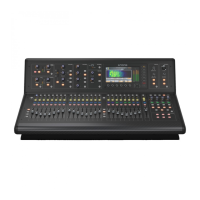56 M32 - Digital Console User Manual 57
9. Adjust the fth control to set the release time of the compressor.
10. Adjust the sixth control to set the makeup gain of the compressor; useful when the compression eect has reduced
the overall signal level of the channel too much.
Page 2
1. Rotary controls 1 & 2 function the same on pages 1 & 2.
2. Adjust the third control to set the steepness of the compressor knee angle between ve separate settings. Adjust
this control to switch between a harder sounding, or more transparent compressor eect.
3. Tap the third control to move the compressor eect before or after the EQ in the channel signal path.
4. Adjust the fourth control to set the frequency of the key lter that can be used to trigger the compressor.
5. Tap the fourth control to toggle the key lter on/o, allowing a specic frequency to control the compressor.
6. Adjust the fth control to set the steepness of the EQ slope used in the compressor.
7. Tap the fth control to send the key source to the solo bus, allowing the key source to be monitored and evaluated.
8. Adjust the sixth control to select the specic key source to be used, Choices include ‘Self’ (the channel’s own sig-
nal), as well as any other input/output of the console.
9. Tap the sixth control to assign the selected key source to the compressor.
eq
The eq tab displays all aspects of the channel EQ,
and also displays a detailed visual graphic of the
current EQ curve. This tab can also be accessed
directly by pressing the VIEW button on the top
panel EQUALISER section.
1. If the currently selected channels is an
input, the channel EQ contains four bands,
with various aspects of each band adjust-
ed by rotary controls 2-5.
2. If the currently selected channel is a bus,
the channel EQ contains six bands, with
various aspects of each band adjusted by encoders 1-6.
3. On the EQ screen, the various rotary controls are always tied to the various EQ bands, and the Up/Down navigation
controls are used to toggle whether the four/six rotary controls adjust:
• Gain
• Frequency
• Width
• EQ mode.
Page 1 (Gain)
1. Adjust the rst rotary control to set the frequency of the channel low-cut lter.
2. Tap the rst control to toggle the low-cut lter in/out of the signal path.
3. Adjust the second control to boost/cut the gain of the low band.
4. Adjust the third control to boost/cut the gain of the low-mid band.
5. Adjust the fourth control to boost/cut the gain of the high-mid band.
6. Adjust the fth control to boost/cut the gain of the high band.
7. Tap the sixth control to toggle the EQ in/out of the signal path.
Page 2 (Frequency)
1. Works as above, but the rotary controls now adjust the frequency centre points for the dierent EQ bands.
Page 3 (Width)
1. Works as above, but the rotary controls now adjust the bandwidth for the dierent EQ bands. Use a narrow slope
for working with a specic frequency, or use a broader slope for general tone-shaping.
Page 4 (Mode)
1. Works as above, but the rotary controls now adjust the EQ mode for each EQ band. Choices include:
• Low cut
• Low shelf
• Parametric EQ
• Vintage EQ
• High shelf
• High cut.
sends
The sends tab displays and controls all aspects
of the channel sends to the 16 mix buses. Com-
pared to the dedicated top panel send controls,
this screen oers additional functions, such as
send muting and simultaneous metering of the
selected channel’s 16 sends. This tab can also be
accessed directly by pressing the VIEW button in
the top panel SENDS section.
The sends tab contains the following param-
eters that can be adjusted using the six rotary
controls:
Page 1
1. Adjust the rst rotary control to set the level for the rst send of the currently selected four-send group.
2. Tap the rst control to mute the rst send of the currently selected four-send group.
3. Repeat the process with the next three controls for the remaining three sends in the currently selected four-send
group.
4. Adjust the sixth control to select which four sends to control with the rotary controls, shifting focus two sends at a
time.
5. Tap the sixth control to select which four sends to control with the rotary controls, shifting focus four at a time.
Page 2
www.theaudiospecialists.eu

